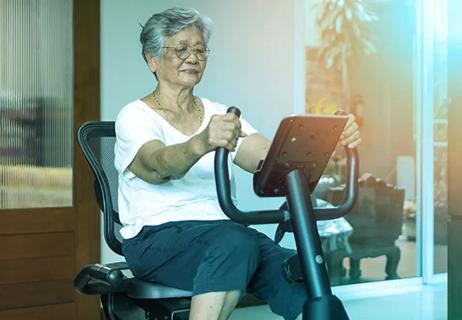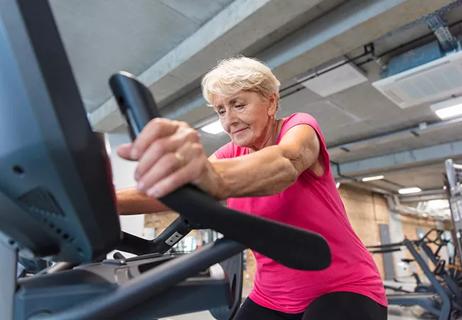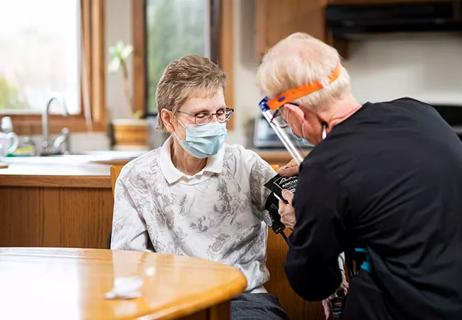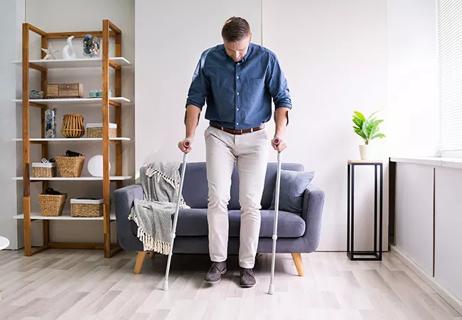Interhemispheric inhibition study signals potential for tailored therapy

In patients with post-stroke unilateral upper limb paresis, the relationship between motor impairment and interhemispheric inhibition is nonlinear (i.e., bimodal) and a threshold impairment level can be defined to stratify patients to individualized therapy. So concludes a recent Cleveland Clinic study (Clin Neurophysiol. 2020;131:2516-2525) with important implications for the design of tailored brain stimulation protocols in post-stroke rehabilitation.
Advertisement
Cleveland Clinic is a non-profit academic medical center. Advertising on our site helps support our mission. We do not endorse non-Cleveland Clinic products or services. Policy
“Our findings align with the recently postulated ‘bimodal-balance recovery’ model proposed by Di Pino and colleagues (Nat Rev Neurol. 2014;10:597-608), which holds that contralesional influence varies in a bimodal fashion across distinct levels of ipsilesional reserve in patients with chronic stroke paresis,” says the study’s senior and corresponding author, Ela Plow, PhD, PT, of Cleveland Clinic’s Department of Physical Medicine and Rehabilitation.
In an editorial accompanying Dr. Plow’s study (Clin Neurophysiol. 2020;131:2488-2490), Dr. Di Pino himself concurs, noting that the Cleveland Clinic study supports and builds on the model theorized by his group. He and a co-editorialist write: “[These findings] have great potential to become biomarkers useful to identify patients who may benefit from neuromodulation of either the contralesional or ipsilesional hemisphere, and to develop individualized protocols of brain stimulation for rehabilitation after stroke.”
The influence that contralesional motor cortices — i.e., those in the hemisphere unaffected by stroke — may have on post-stroke motor function of a paretic upper limb has been controversial. Initial theories favored a negative influence, but more recent evidence has suggested a positive effect.
That was the context in which Di Pino and colleagues proposed their bimodal-balance recovery hypothesis in 2014, which suggested that the role of contralesional motor cortices may vary according to the amount of ipsilesional reserve (i.e., reserve in the stroke-affected hemisphere) and neural pathways that are available to contribute to recovery. The idea is that the contralesional influence is inhibitory to paretic limb motor function when there is limited damage (high ipsilesional reserve) but is supportive to motor function when damage is more severe (low ipsilesional reserve).
Advertisement
“This hypothesis implies that there may be a threshold level of ipsilesional reserve for determining the effect of contralesional cortex on patients’ motor function,” says Dr. Plow. “We undertook our study to explore the relationship between contralesional influence and ipsilesional reserve in patients with chronic stroke. We specifically aimed to identify a threshold level of reserve that defines patient subgroups stratified according to response. We also aimed to confirm the threshold by evaluating whether contralesional influence in fact evolves distinctly in the stratified patient subgroups after a course of rehabilitation.”
Twenty-four adults with unilateral upper limb paresis following a stroke were enrolled (mean age, 61.7 years). Patients underwent baseline assessments of the following:
UEFM and DTI assessments were repeated after five weeks of upper limb rehabilitation, which was successfully completed by 21 of the 24 patients.
Among the primary findings:
Advertisement
“These findings show that interhemispheric inhibition shares a bimodal relationship with the severity of a patient’s baseline impairment and thus provide support for the bimodal-balance recovery hypothesis,” observes Dr. Plow. “They also show that reduction of interhemispheric inhibition is a functionally relevant mechanism and that the threshold identified here — UEFM score above or below 43 — may serve as a suitable criterion for stratifying patients for development of precise treatments.”
She adds that the results suggest that undamaged, contralesional motor cortices may support motor improvement of paretic limbs in more-severely affected patients by reducing interhemispheric inhibition on weak motor regions, enabling better movement control.
She points out that the UEFM criterion identified in this small study needs to be validated in a larger patient sample. “Nevertheless, our results show that a threshold impairment level can be determined to assign patients to subgroups based on the bimodal influence of contralesional cortex,” she notes. “A threshold of this type has promising potential for use in stratifying chronic stroke patients for tailored therapies that align with individual biologic targets and thereby have greater likelihood of being effective.”
Advertisement
Advertisement

Group program offers adapted exercises and lifestyle education to individuals in need

Research to test clinical efficacy and cost-effectiveness versus standard-of-care rehab

Pilot study finds both forced- and voluntary-rate cycling effective for symptom management

Gait becomes more normalized along with gains in speed

Training in stretches, emphasis on biomechanics help ease work-related pain, survey finds

High-intensity cycling program leads to improved walking capacity and upper extremity function

Novel post-acute care model aims to improve functional outcomes with reduced costs

More evidence needed on pharmacologic therapy alone and combined with gait training